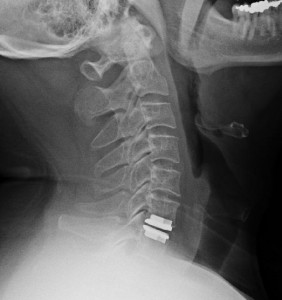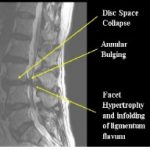What is Cervical Total Disc Replacement?
Cervical total disc replacement is a type of spinal surgery in which a complete spinal disc in the cervical, or neck region of the spine, is removed and replaced with an artificial disc. This surgery is also called cervical total disc arthroplasty. This procedure has been used in Europe for close to 20 years and was approved by the US FDA over five years ago. Cervical disc replacement provides an additional surgical option for patients suffering from a cervical disc herniation who do not respond to conservative therapies. Here at New Jersey Spine Specialists in Summit, we’ve been getting more questions about this procedure from our patients from throughout northern New Jersey and beyond.
Spinal, or intervertebral discs, act as cushions and shock absorbers between vertebrae in the spine. As we age or after an injury these discs can bulge out of place or degenerate thus losing their cushioning ability. A large enough disc bulge is referred to as a herniated disc. When the disc loses its shock absorbing capability, the body reacts by forming bone spurs, which are knows as osteophytes. Herniated discs and osteophytes can put pressure on the nerves in and emanating from the spinal column which can result in neck and arm pain, numbness, tingling, and weakness. Artificial cervical disc replacement is a surgical procedure in which the damaged or herniated disc is removed and the pressure on the nerves thereby relieved. Once the disc is removed, the vertebrae on either side are spread apart, further reducing pressure on the spinal nerves. Since the disc in in the front portion of the spine, it is removed through a small incision placed in the front of the neck. After the disc is removed, an artificial disc is inserted into the remaining space between the vertebrae. Patients can typically leave the surgical facility the same day the procedure is performed with limited restrictions on activities.
Back Pain Treatment with a Cervical Total Disc Replacement
Cervical total disc replacement was developed as an alternative to the more traditional anterior cervical discectomy and fusion (ACDF) procedure.. An ACDF is very similar to a disc replacement in that the disc is removed, but instead of using a disc replacement, in ACDF a piece of bone graft is placed between the adjacent vertebrae causing them to grow together (fuse). In a fusion, a plate is typically placed on the front of the vertebra to provide additional stability while the bones grow together. A fusion eliminates the natural movement of the spine between the fused vertebrae. In contrast, cervical total disc replacement surgery retains the natural motion of the vertebrae. A disc replacement also avoids the need for a plate and does not have a risk of non-healing (nonunion) that can occur with anterior cervical discectomy and fusion surgery.
Fortunately, most spinal problems can be treated effectively with conventional therapies such as medication and physical therapy. If a neck problem is affecting your quality of life, we recommend consulting a physician specializing in spinal conditions.








